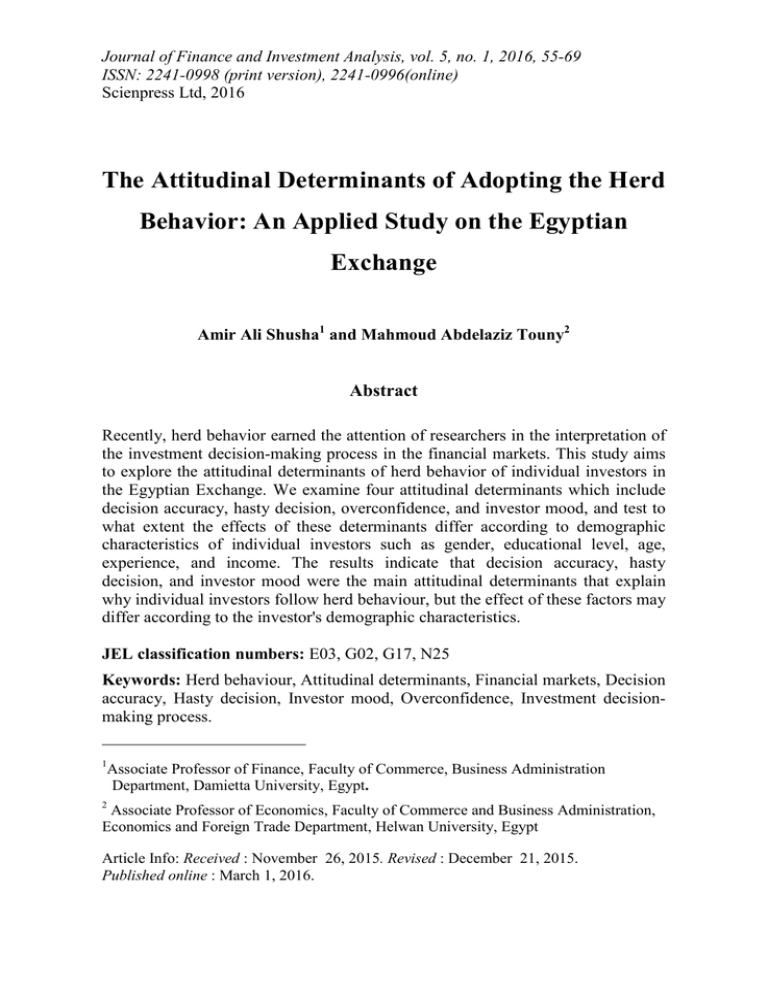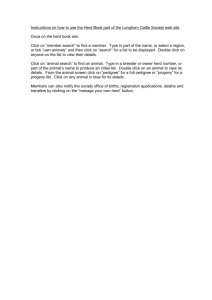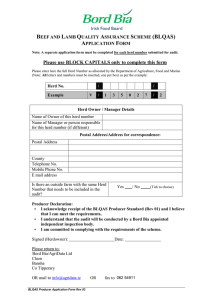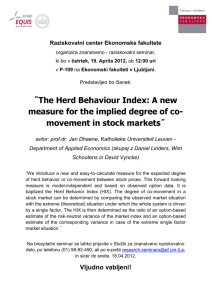Journal of Finance and Investment Analysis, vol. 5, no. 1,... ISSN: 2241-0998 (print version), 2241-0996(online)
advertisement

Journal of Finance and Investment Analysis, vol. 5, no. 1, 2016, 55-69 ISSN: 2241-0998 (print version), 2241-0996(online) Scienpress Ltd, 2016 The Attitudinal Determinants of Adopting the Herd Behavior: An Applied Study on the Egyptian Exchange Amir Ali Shusha1 and Mahmoud Abdelaziz Touny2 Abstract Recently, herd behavior earned the attention of researchers in the interpretation of the investment decision-making process in the financial markets. This study aims to explore the attitudinal determinants of herd behavior of individual investors in the Egyptian Exchange. We examine four attitudinal determinants which include decision accuracy, hasty decision, overconfidence, and investor mood, and test to what extent the effects of these determinants differ according to demographic characteristics of individual investors such as gender, educational level, age, experience, and income. The results indicate that decision accuracy, hasty decision, and investor mood were the main attitudinal determinants that explain why individual investors follow herd behaviour, but the effect of these factors may differ according to the investor's demographic characteristics. JEL classification numbers: E03, G02, G17, N25 Keywords: Herd behaviour, Attitudinal determinants, Financial markets, Decision accuracy, Hasty decision, Investor mood, Overconfidence, Investment decisionmaking process. 1 Associate Professor of Finance, Faculty of Commerce, Business Administration Department, Damietta University, Egypt. 2 Associate Professor of Economics, Faculty of Commerce and Business Administration, Economics and Foreign Trade Department, Helwan University, Egypt Article Info: Received : November 26, 2015. Revised : December 21, 2015. Published online : March 1, 2016. 56 Amir Ali Shusha and Mahmoud Abdelaziz Touny 1 Introduction In the past few decades, the behavioral finance theory has emerged to compete strongly the classical theory of finance. While the classical finance focuses on the logical justifications in the process of investment decisions, the behavioral finance takes into account the psychological and behavioral aspects of this process. Behavioral finance deals with individuals and their ways of collecting and using information. Therefore, the inclusion of behavioral factors as well as the economic factors has contributed to the improvement of investment decision-making process (Olsen, 1998). Many behavioral finance studies have addressed the phenomenon of deviations in the individual investors' decisions from rational tracks which couldn't be explained by the classical theory. Several studies such as Coval and Shumway (2005) and Kumar and Lee (2006) illustrated that the irrational behavior of investors has significant impact on price trends in the stock markets. The theory of market efficiency is based on a set of assumptions including that the investor behavior is rational. In this regard, practitioners believe that the behavior of most individual investors in the financial market is characterized by irrationality, and they cite on the waves of optimism and pessimism that prevail in the financial markets from time to time and herd behavior. Herd behavior represents an outcome of psychological motivators of investment decisions, which may provide an explanation for excess volatility of prices. In recent years, there has been much interest, both theoretical and empirical, on the extent to which trading in financial markets is characterized by herd behavior. Such an interest stems from the effects that herding may have on the stability of the financial market and its efficiency. In some cases, it is possible that rational traders may follow herd behavior due to different sources of uncertainty in the financial market (Cipriani and Guarino, 2008). Literature review in the field of herd behavior has been concentrated in three main trends. The first trend focuses on whether herd behavior is existed in financial markets or not. Most of these studies confirm that herd behaviour is mostly common in emerging markets. Another research stream of herd behavior has focused on the differences between individuals and institutional investors of adopting herd behavior. However, few empirical studies explain exactly what causes herding. According to the lack of such empirical studies in this point, the current study tries to investigate some attitudinal determinants of individual investors in the Egyptian Exchange that may explain why those investors follow herd behavior. Add to that, this study tries to discover whether the effect of these attitudinal determinants differ according to investor demographic characteristics using interactive variables between demographic and attitudinal variables to check the moderating role of demographical variables on the relationship between the attitudinal variables and herd behaviour. The Attitudinal Determinants of Adopting the Herd Behavior 57 According to Morgan Stanley Corporation’s report (2013) on the performance of global markets, the Egyptian Exchange was ranked as second in the emerging markets, and this explains why we apply our study on the Egyptian market. The Egyptian Exchange is one of the oldest stock markets established in the Middle East. The Egyptian Exchange traces its origins to 1883 when the Alexandria Stock Exchange was established, followed by the Cairo Stock Exchange in 1903. 2 Literature Review The theory of market efficiency is based on a set of assumptions including that investor behavior is rational in which he/she collects and analyzes information before taking the investment decision. However, monitoring the movements of the market, which oscillates between the waves of bullish and bearish, indicates that the behavior of most investors is irrational. Add to that, the process of gathering and analyzing of data needs professional skills and high costs which may lead some individual investors to adopt herd behavior. Psychologically, when people communicate on an ongoing basis, usually they think in similar manner, which makes their responses to the same situations to be similar because of the similarity of their reactions. Accordingly, the individual tends to herd when mainly follows the actions of others (Bikhchandani et al., 1992 and Shiller, 2000). Several economic studies such as De Long et al. (1990); Froot and Obstfeld (1991) and Hey and Morone (2004) referred to the strong relationship between bubbles and crashes in financial markets and speculative or irrational behavior of market participants. Similarly, financial studies such as Bikhchandani et al. (1992); Nofsinger and Sias (1999) and Blasco et al. (2012) focus on pricing inefficiencies and argue that herding behavior can drive security prices away from equilibrium values supported by fundamentals and drive volatility in the market. Following the historical movements of the market indicates that irrationalities in investment behavior have been the reason behind major booms and busts in the market. Herd behavior is a challenge to the efficient market hypothesis, which is unable to provide an explanation for this phenomenon. There are several definitions of herd behavior in the literature review. Banerjee (1992) defined the herd behavior as "the phenomenon of people following a crowd for a given period sometimes even regardless of individual information suggesting something else". In stock markets, Tan et al. (2008) described herd behavior as a behavioral tendency for an investor to follow the actions of other investors. Also, Bikhchandani and Sharma (2001); Demirer and Kutan (2006) and Choi and Sias (2009) defined herding as the situation when a group of stock investors blindly follow other investors in either buying or selling stocks overtime. In this context, Bikhchandani et al. (1992), Lux (1998) explained the phenomenon of herd behavior as investor's respond to group pressure. Moreover, Banerjee (1992) showed that herd behavior may result from private information that not publicly 58 Amir Ali Shusha and Mahmoud Abdelaziz Touny shared. On the other hand, Avery and Zemsky (1998) defined herd behavior as a trade by an informed agent which follows the trend in past trades even though that trend is counter to his initial information about the asset value. Recently, Mandal (2011) defined herd behavior as the tendency of an individual to imitate other individuals as he/ she believes that their information is more accurate than his own privately information. According to Scharfstein and Stein (1990) and Bikhchandani and Sharma (2001), herding behavior can be rational or irrational. Herding can be rational if the investor's actions are intentional whereas irrational herding means that the actions of the investor are non-intentional as the investor disregards his prior beliefs and blindly follows other investors’ decisions (Christie and Huang,1995; Devenow and Welch, 1996). Rational herding can be supported by the theory of planned behavior which assumed that planned behavior can be used in anticipating human behavior, where the theory of reasoned action supposed that intentions can be considered as a mediator variable between the behavioral motivators and the behavior itself (Ajzen and Fishbein, 1980; Ajzen, 1991, 2002). A number of studies in the finance and experimental economics literature have examined the possible motives behind herding behavior in financial markets. Some of these studies provide support for rational asset pricing models whereas other studies find significant evidence of herding behavior. One of the important research streams in the field of herd behavior has focused on whether there is a herd behavior in financial markets or not. For example, Chang et al. (2000) found that herding was present in emerging economies like South Korea and Taiwan. Also, Mandal (2011) examined the effect of informational asymmetries in the emerging markets on the presence of herd behavior. He found highly significant herding in the Indian Stock Exchange indicators through the period 1997-2008 especially during the bull times rather than bear times. Moreover, Almeida et al. (2012) investigated the presence of herd behavior in Latin American and the United States stock markets. Their results indicated that there is asymmetric herd behavior in the Chilean, United States, Argentinean, and Mexican markets. Add to that, Brahmana et al. (2012) by using firm-level data of 846 Bursa Malaysia stocks during 1990–2010 found that herd behavior is the determinant for investors' Monday irrationality, especially in small industries. Using daily price data on 305 American Depository Receipts traded in US exchanges issued by corporations from 19 countries, Demirer et al. (2014) provided significant evidence of herding behavior and also found a significant correlation between financial crises and herding behavior. Also, Khan (2014) demonstrated that investor decisions are subjective to behavioral factors and peer pressures rather processing of private information in Pakistan. Contrary to these studies, Prosad et al. (2012) showed that herd behavior is not present in Indian Stock market for the period of 2006 to 2011. Another research stream in this field has focused on the differences between individuals and institutional investors of adopting herd behavior. For instance, Ndungu (2012) studied the behavioral determinants of individual investors at the The Attitudinal Determinants of Adopting the Herd Behavior 59 Nairobi Securities Exchange. He concluded that there are four behavioral factors that determine the investment decisions of individual investors which are heuristics, market, prospect and herding. The results indicated mixed reaction in regard to the dimension of overconfidence as investors believe that their skills and knowledge of the securities market can help them outperform the market. However, the research findings indicated that herding variables have a low impact on the investors' decisions. On the other hand, Shiller and Pound (1989) indicated that herding behavior existed among institutional investors. They found that institutional investor put emphasis on the advice of other professionals in making their investment decisions in volatile stocks. Also, Al-Shboul (2013) by using data of 43 financial firms and 112 nonfinancial firms in the Jordanian equity market confirmed the absence of nonlinear herding for financial firms in normal and extreme market conditions but confirmed the existence of nonlinear herding for nonfinancial firms. Lin et al. (2013) examined the relationships between herding of various investor groups and trading noise in the Taiwan stock market to determine whether any of the investor groups tend to herd rationally. He found that institutional investors are likely to herd rationally where institutional investors’ herding decreases trading noise. By contrast, herding of individual investors tends to contain limited information and therefore it increases trading noise. In sum, herd behavior is more common among individual investors rather than institutional investors. Recently, there is a new trend in literature of herd behavior to examine demographic and psychological determinants of this behavior. For example, Rekik and Boujelbene (2013) investigated the demographic and psychological determinants of individual investors’ behavior in the Tunisian stock market. Their results provided evidence of the existence of irrational financial behavior where the Tunisian investors’ behaviors are subject to five behavioral biases: representativeness, herding attitude, loss aversion, mental accounting, and anchoring. They explained these results due to the interaction between the psychological biases and the demographic factors. Add to that, Phan and Zhou (2014) tested the effect of psychological factors on decisions made by individual investors in the Vietnamese stock market. The results indicated that an individual’s investment intention is significantly affected by his attitude towards investment, subjective norm and perceived behavioral control. The study also provided strong evidences for the existence of psychological factors which include overconfidence, excessive optimism, and psychology of risk and herd behavior which have significant impact on individuals’ attitudes towards investment. Add to that, their results provided evidence that gender has a strong moderating effect between the psychological factors and individuals' investment decisions. The current study describes herd behaviour as investment behaviour, so we seek to explain this behaviour through some demographic and attitudinal factors. In this context, our study differs from some other studies which deal with herd behaviour as a determinant of investment behaviour. This study tries to examine these relationships among individual investors in the Egyptian Exchange which 60 Amir Ali Shusha and Mahmoud Abdelaziz Touny represent one the most important emerging markets. The main hypothesis of our study is herding behavior of individual investors is affected by some attitudinal factors which include decision accuracy, hasty decision, overconfidence, and investor mood. Therefore, the model can be formulated by this chart: Attitudes - Decision Accuracy - Hasty Decision - Overconfidence - Investor Mood Herd Behaviour Demographic Factors - Gender - Education Chart 1:The study model - Age - Experience - Income 3 Research Methodology Our study depends on data collected by a questionnaire that randomly distributed on 400 investors in Egyptian Exchange, in which 255 of them responded with a response rate about 64%. The questionnaire is attached in the appendix. Table 1 summarizes the specification of the demographic variables of our sample. 61 The Attitudinal Determinants of Adopting the Herd Behavior Table 1: Description of demographic variables Variable Gender Male Female Age < 35 years ≥ 35 years Education Higher Education Mediate Education Experience < 5 years ≥ 5 years Annual Income < 30,000 ≥ 30,000 Frequency Percent 53 202 21% 79% 112 143 44% 56% 201 54 79% 21% 147 108 58% 42% 140 115 55% 45% With regard to the attitudinal determinants that motivate investors to adopt the herd behavior, we study four variables which include decision accuracy, hasty decision, overconfidence, and investor mood. We measured the statements of these variables by 5 point Likert scale, where 1 means strongly disagree and 5 means strongly agree, and in case of reverse items, 1 means strongly agree and 5 means strongly disagree. The accuracy of a decision refers to the extent to which such a decision would agree with the optimal decision. Investor who tends to take his decision accurately depends on analyzing the economic and financial situation of his portfolio rather than depending on herd behavior. Therefore, it is assumed that investors with high level of decision accuracy are less likely to adopt herd behaviour. Hasty decision means that the reaction of an investor is too quickly to be accurate or wise. This situation may be as a result of his inexperience in reading market trends and therefore he/she is more likely to follow the actions of other people in the market. Overconfidence is known as the investor's tendency to perceive himself as skillful. On this basis, Odean (1998) assumes that investors tend to overestimate their own capabilities. Overconfidence seems to be related to herd behavior. It is expected that people with high level of overconfidence are less likely to adopt herd behavior. Investor mood refers to the overall attitude of investors toward a particular security or financial markets. Psychological factors may leave significant impact on their attitude and behavior. When people are in good mood, they become more optimistic in their judgments but when they are not, they turn more pessimistic [Phan and Zhou, 2014]. As the investment decision is influenced by investor mood 62 Amir Ali Shusha and Mahmoud Abdelaziz Touny as the investor is more likely to follow the herd behavior. Herding often occurs when many people take the same action, perhaps because some imitate the actions of others when taking the investment decision (Graham, 1999). The validity of this study variables is tested using factor component analysis and each item that does not add value to the scale is excluded, which its component value less than 0.4 (Hinkin, 1995). After that, the reliability of variables is tested using Cronbach's alpha test and the results indicate that alpha coefficients of all variables are more than the standardized value which is 0.7 accordingly to Nunnally and Bernstein (1994) (see table 2). Table 2: Results of factor component analysis and Cronbach's Alpha Factor loading (Cronbach's α) Herd behavior (0.74) Other investors’ decisions of buying and selling stocks have impact on 0.80 your investment decisions. You consider the information from your close friends and relatives as 0.80 the reliable reference for your investment decisions. Link my decision to the level of stock prices regardless of other factors. 0.70 Overconfidence (0.83) You rely on your previous experiences in the market for your next 0.81 investment. I forecast the changes in stock prices in the future based on the recent 0.69 stock prices. My personal opinion is essential in taking my investment decision. 0.61 Hasty decision (0.75) I consider carefully the price changes of stocks that you intend to invest 0.52 in. I usually react quickly to the changes of other investors’ decisions and 0.73 follow their reactions to the stock market. Speed decision-making without checking the veracity of the 0.68 information. Decision Accuracy (0.90) Slowdown in the reaction in the case of a single source of information. 0.72 Slowed in reaction out of fear of the fact that information is just rumors. 0.81 My reaction depends on multiple sources of information. 0.45 My reaction depends on linking between the available information. 0.61 Mood (0.77) My pessimism affects my investment decision. 0.80 My optimism affects my investment decision. 0.74 My mood affects my investment decision. 0.80 Variable Or Items 63 The Attitudinal Determinants of Adopting the Herd Behavior 0 .2 Density .4 .6 As the dependent variable is the average of some categorical variables, it is therefore an interval variable that ranges between 1 and 5. In this case, we can use OLS to estimate our model. We design three regression models, where the first model includes only demographic variables; the second model includes both demographic and attitudinal variables, whereas the third model includes the interactive variables between demographic and attitudinal variables to check the moderating role of demographical variables on the relationship between the attitudinal variables and herd behaviour. In order to check the stochastic nature of our data, and if there is a bias in the data because of non-random reasons, we apply the histogram of the error term of the second estimated model to check the normality of the errors. According to figure (1), it is clear that the errors are normally distributed and free from bias, therefore we can apply the OLS estimate. -2 -1 0 1 2 Residuals Figure 1: The histogram of the error term In order to avoid the problem of heteroscedasticity which is likely to be more common in cross sectional data than in time series data, we estimated the OLS model using robust standard error. Even if there is no heteroskedasticity, the robust standard errors will become just conventional OLS standard errors. Thus, the robust standard errors are appropriate even under homoskedasticity. 4 Results and Discussion Before estimating our models, we carried out correlation analysis to check for multicollinearity problem between independent variables. The results of pairwise correlations in table 3 indicate that our data are free of multicollinearity problem as the highest correlation coefficient between variables is 0.36. 64 Amir Ali Shusha and Mahmoud Abdelaziz Touny Table 3: Correlation matrix of dependent variables. Variables 1 2 3 4 5 6 7 8 1. Gender 1 2. Education 0.07 1 3. Age -0.12 -0.01 1 4. Experience 0.20* 0.19* 0.23* 1 * * 5. Income -0.22 0.10 0.36 0.12 1 6. Decision Accuracy 0.08 -0.26* -0.07 -0.01 -0.33* 1 * * * 7. Hasty Decision 0.30 -0.04 -0.18 0.08 -0.25 0.21* 1 8. Overconfidence 0.15* 0.16* -0.08 0.16* 0.07 0.05 0.20* 1 9. Investor Mood -0.13* -0.06 0.13* -0.05 0.02 0.32* -0.12 0.05 * means significant at 5% Table 4 displays the results of the estimated models using OLS. The results of model (1) indicate that education and experience of investor have a significant negative impact on the tendency of investors to adopt herd behaviour. Inserting attitudinal variables in the regression model (as shown in model 2) improves the explanatory power of the model as the R2 increases from 11% to 33%. According to the results of model (2), decision accuracy, hasty decision, and investor mood seem to have a significantly positive impact on adopting herd behaviour. These results show the direct impact of attitudinal variables on adopting herd behaviour, but these relationships may be moderated by demographic characteristics of investors. Therefore, we insert the interactive relationship between demographical and attitudinal variables in model (3) in order to examine the moderating role of these demographic factors. With regard to the gender of investor, the results show the gender does not play a moderating role between attitudes of investors and their tendency to adopt herd behaviour. On other words, the effect of attitudinal variables on adopting herd behaviour does not differ with the gender of investor. With regard to the education level of investors, it is clear that education plays a moderating role between decision accuracy and herd behaviour. This implies that decision accuracy seems to have a positive impact of adopting herd behaviour for high educated investors, whereas investors with low level of education their tendency to adopt herd behaviour is explained by hasty decision. In case of the age of investor, the outcomes indicate that the age has a moderating role between each of hasty decision and investor mood and adopting herd behaviour. These results mean that adopting herd behavior by old investors is determined by their hasty decision and investor mood, where adopting herd behaviour by young investors is determined by decision accuracy. On the other hand, experience of the investor moderates the relationship between decision accuracy and herd behaviour, as the decision accuracy seems to have a 65 The Attitudinal Determinants of Adopting the Herd Behavior positive impact on adopting herd behaviour for more experienced investors. However, the decision of investors with low level of experience is determined by hasty decision and their mood. At last, the income of investor also has altered the relationship between hasty decision and herd behaviour, where hasty decision has a positive and significant impact on adopting herd behaviour for investors of high income. However, the herd behaviour of low income investors is determined by decision accuracy and their mood. The value of F-test of all models is significant at 1 percent which indicates that our models are well fit. Table 4: The interactive effect of demographic factors on the motives of the individual investor to adopt herd behaviour Variable Model (1) Model (2) * Gender Education Age Income ** 2.40** 0.91 0.18 -0.12 0.10 -0.57** 0.23 -0.35 0.68** 0.30 0.38* 0.37** -0.21 -0.19 0.03 10.79** 1.98 0.22 -0.16 -1.77* -0.59** 0.20 0.56** 0.04 -0.10 0.14 -0.26 0.38** 0.08 0.27** 15.82** 1.32 0.13 -0.19* 0.11 -1.33 0.16 0.16 0.28** 0.03 0.58** 0.46** 0.01 -0.05 -0.20 12.87 2.16** 0.16 -0.23* 0.05 -0.55** -1.44 0.32** -0.06 0.06 0.55** -0.03 0.59** -0.14 -0.02 16.16** 0.33 0.35 0.34 0.38 0.36 0.40 0.91 0.17 -0.13 0.11 -0.57** 0.20 0.36** 0.27** -0.04 0.50** R2 ** Experience 0.99 -0.10 -0.10 0.09 -0.59** 0.23 0.58** 0.32** -0.24 0.33* -0.23 -0.08 0.26 0.11 13.59** Constant 4.35 Gender 0.24 Education -0.34** Age 0.14 Experience -0.52** Income -0.07 Decision Accuracy Hasty Decision Overconfidence Investor Mood DF * Decision Accuracy DF * Hasty Decision DF * Overconfidence DF * Investor Mood F(sig) 5.94** 0.11 β(sig) of demographic factors (DF) Model (3) Note: * significant at 5%, ** significant at 1% In general, overconfidence seems to have no effect on adopting herd behavior in all models. This result can be explained by Dunning-Kruger Effect which implies that the effect of overconfidence differs according to the level of experience. This effect refers that the overconfidence of relatively unskilled individuals is relatively high but this overconfidence is unrealistic as people in this stage fail to adequately assess their level of competence and thus consider themselves much more competent than everyone else leading to a significant overestimate of themselves (Kruger and Dunning, 2009). With an increase of individual's experience, this fake 66 Amir Ali Shusha and Mahmoud Abdelaziz Touny overconfidence tends to back down and after a certain level of experience real overconfidence of individuals tends to increase with the increase in the level of experience. Therefore, we expect that the relationship between overconfidence and adopting herd behaviour is non-linear which could be the focus of future studies. 5 Conclusion This study aims to explore the attitudinal and demographic determinants of herd behavior of individual investors in the Egyptian Exchange. We examine four attitudinal determinants which include decision accuracy, hasty decision, overconfidence, and investor mood, and test to what extent the effects of these determinants differ according to demographic characteristics of individual investors such as gender, educational level, age, experience, and income. The study depends on data collected by a questionnaire that covers 255 respondents and we utilized OLS technique to test our models. The results of the estimated models indicate that decision accuracy, hasty decision, and investor mood were the main attitudinal determinants that explain why individual investors follow herd behavior, but the effect of these factors may differ according to the investor's demographic characteristics. However, overconfidence seems to have no effect on adopting herd behavior in all models. As the current study concentrated mainly on the attitudinal determinants of adopting herd behavior, we recommend future studies to explore the motivational determinants of adopting technical analysis and to what extent the demographic factors of investors can affect this relationship. References [1] I. Ajzen, The theory of planned behavior, Organizational Behavior and Human Decision Processes,50(2), (1991), 179-211. [2] I. Ajzen, Perceived behavioral control, self-efficacy, locus of control, and the theory of planned behavior, Journal of Applied Social Psychology,32(4), (2002), 665-683. [3] I. Ajzen and M. Fishbein, Understanding attitudes and predicting social behavior, Englewood Cliffs, NJ: Prentice-Hall, 1980. [4] R. Almeidaa, H. Costab and N. da Costa Jr, Herd behavior in Latin American stock markets, Latin American Business Review,13(2), (2012), 81-102. The Attitudinal Determinants of Adopting the Herd Behavior 67 [5] M. Al-Shboul, An examination of herd behavior in the Jordanian equity market, International Journal of Economics and Finance, 5(1), (2013), 234249. [6] C. Avery and P. Zemsky, Multidimensional uncertainty and herd behavior in financial markets, American Economic review,88, (1998),724–748. [7] A. Banerjee, A simple model of herd behavior, The Quarterly Journal of Economics,107(3), (1992) 797-817. [8] S. Bikhchandani and S. Sharma, Herd behavior in financial markets: A review, IMF Staff Papers, 47(3), (2001), 279–310. [9] S. Bikhchandani, D. Hirshleifer and I. Welch, A theory of fads, fashion, custom, and cultural change as informational cascades, Journal of Political Economy, 100(5), (1992), 992-1026. [10] N. Blasco,P. Corredor and S. Ferreruela, Does herding affect volatility? Implications for the Spanish stock market, Quantitative Finance,12(2), (2012),311–327. [11] R. Brahmana,C. Hooy and Z. Ahmad, The Role of herd behaviour in determining the investor‘s Monday irrationality, Asian Academy of Management Journal of Accounting and Finance,8(2), (2012), 1-20. [12] E. Chang,J. Cheng and A. Khorana, An examination of herd behavior in equity markets: an international perspective, Journal of Banking & Finance, 24, (2000), 1651-1679. [13] N. Choi and R. Sias, Institutional industry herding, Journal of Financial Economics, 94(3), (2009), 469-91. [14] W. Christie and R. Huang, Following the pied piper: Do individual returns herd around the market?, Financial Analysis Journal,51(4), (1995), 31-37. [15] M. Cipriani and A. Guarino, Transaction costs and informational cascades in financial markets, Journal of Economic Behavior & Organization,68(3–4), (2008), 581-592. [16] J. Coval and T. Shumway, Do behavioral biases affect prices?, Journal of Finance, 60, (2005), 1–34. [17] J. De Long, A. Shleifer, L. Summers and R. Waldmann, Noise trader risk in financial markets, Journal of Political Economy,98(4), (1990), 703–738. [18] R. Demirer and A. Kutan, Does herding behavior exist in Chinese stock markets, Journal of International Financial Markets, Institutions and Money,16(2), (2006), 123-142. [19] R. Demirer,A. Kutan and H. Zhang, Do ADR investors herd?: Evidence from advanced and emerging markets, International Review of Economics and Finance, 30, (2014), 138–148. 68 Amir Ali Shusha and Mahmoud Abdelaziz Touny [20] A. Devenow and I. Welch, Rational herding in financial economics, European Economic Review,40(3-5), (1996), 603-615. [21] K. Froot and M. Obstfeld, Intrinsic bubbles: The case of stock prices, American Economic Review, 81(5), (1991), 1189–1214. [22] J. Graham, Herding among investment newsletters: Theory and evidence, Journal of Finance, 54, (1999), 237–286. [23] J. Hey, and A. Morone, Do markets drive out lemmings or vice versa?, Economica,71, (2004), 637–659. [24] T. Hinkin, A review of scale development practices in the study of organizations, Journal of Management,21(5), (1995), 967-988. [25] J. Kartašova, Factors forming irrational Lithuanian individual investors' behaviour, Business Systems & Economics,3(1), (2013), 69-78. [26] M. Khan, An empirical investigation on behavioral determinants of perceived investment performance: Evidence from Karachi stock exchange, Research Journal of Finance and Accounting, 5(21), (2014), 129- 137. [27] J. Kruger and D. Dunning, Unskilled and unaware of it: How difficulties in recognizing one’s own incompetence lead to inflated self-assessments, Journal of Personality and Social Psychology, 77(6), (2009), 1121–1134. [28] A. Kumar, and C. Lee, Retail investor sentiment and return comovements, The Journal of Finance, 61(5), (2006), 2451-2486. [29] W. Lin,S. Tsai and P. Lung, Investors’ herd behavior: rational or irrational?, Asia-Pacific Journal of Financial Studies,42, (2013),755–776. [30] T. Lux, The socio-economic dynamics of speculative markets, Journal of Economic Behavior and Organization, 33, (1998), 143–165. [31] A. Mandal, Empirical study of herd behavior: The national stock exchange, India, International Journal of Financial Management, 1(3), (2011), 1-12. [32] D. Ndungu, Determinants of individual investors’ behaviour in the Nairobi Securities Exchange, Master Thesis, School of Business, University of Nairobi, 2012. [33] J. Nofsinger and R. Sias, Herding and feedback trading by institutional and individual investors, Journal of Finance,54, (1999), 2263–2295. [34] J. Nunnally and I. Bernstein, Psychometric theory, 3rd ed., New York, NY: McGraw-Hill, Inc, 1994. [35] T. Odean, Volume, volatility, price and profit when all investors are above average, Journal of Finance, 53, (1998), 1887-1934. [36] R. Olsen, Behavioral finance and its implications for stock price volatility, Financial Analysts Journal, 54(2), (1998), 10-18. The Attitudinal Determinants of Adopting the Herd Behavior 69 [37] K. Phan and J. Zhou, Factors influencing individual investor behavior: an empirical study of the Vietnamese stock market, American Journal of Business and Management,3(2), (2014), 77-94. [38] J. Prosad, S. Kapoor and J. Sengupta, An examination of herd behavior: An empirical evidence from Indian equity market, International Journal of Trade, Economics and Finance,3(2), (2012), 154-157. [39] Y. Rekik and Y. Boujelbene, Determinants of individual investors’ behaviors: Evidence from Tunisian stock market, IOSR Journal of Business and Management,8(2), (2013), 109-119. [40] D. Scharfstein and J. Stein, Herd behavior and investment, The American Economic Review,80(3), (1990), 465-479. [41] R. Shiller and J. Pound, Survey evidence of diffusing interest among institutional investors, Journal of Economic Behavior and Organization, 12, (1989), 47-66. [42] R. Shiller, Irrational exuberance, Princeton: Princeton University Press, 2000. [43] L. Tan,T. Chiang, J. Mason and E. Nelling, Herding behavior in Chinese stock markets: an examination of A and B shares, Pacific-Basin Finance Journal,16, (2008), 61–77.








